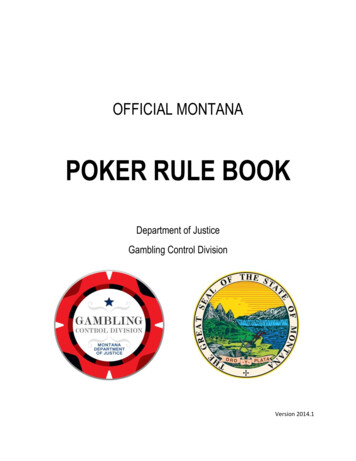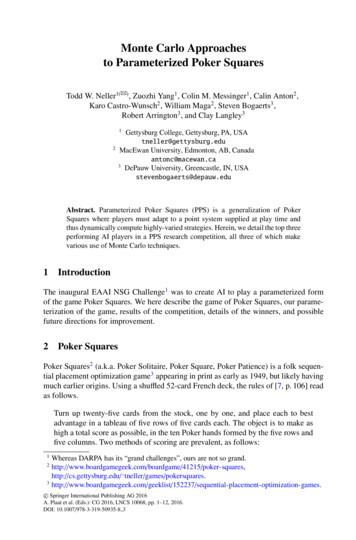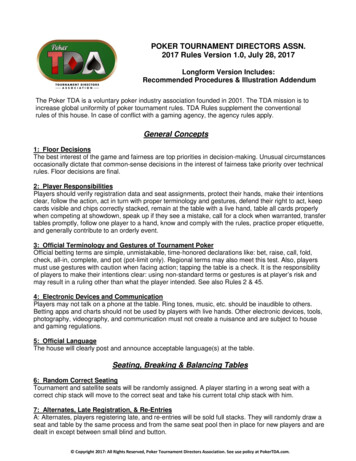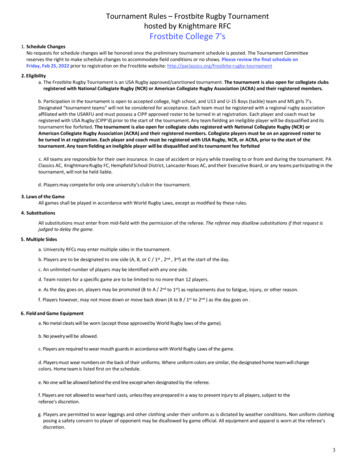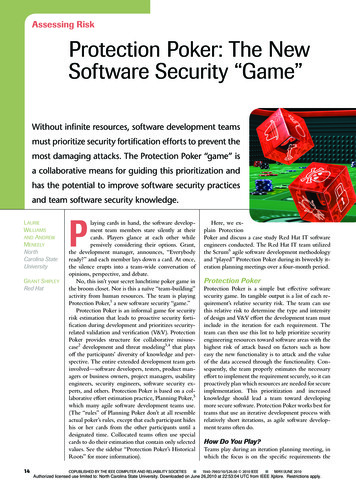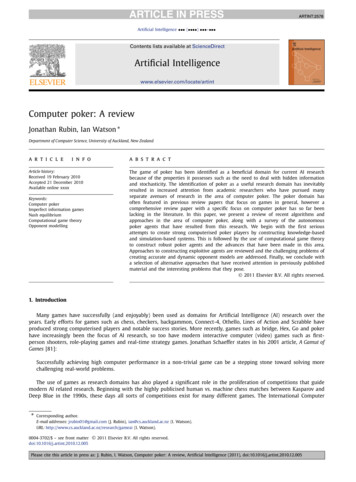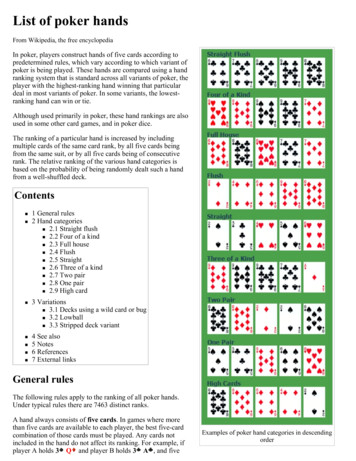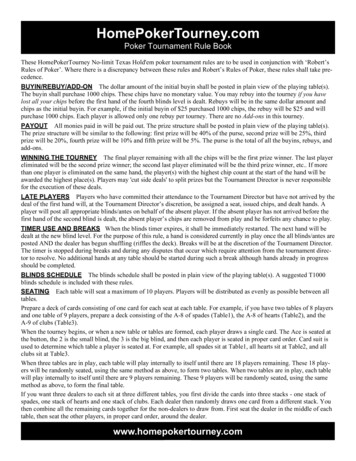
Transcription
HomePokerTourney.comPoker Tournament Rule BookThese HomePokerTourney No-limit Texas Hold'em poker tournament rules are to be used in conjunction with ‘Robert’sRules of Poker’. Where there is a discrepancy between these rules and Robert’s Rules of Poker, these rules shall take precedence.BUYIN/REBUY/ADD-ON The dollar amount of the initial buyin shall be posted in plain view of the playing table(s).The buyin shall purchase 1000 chips. These chips have no monetary value. You may rebuy into the tourney if you havelost all your chips before the first hand of the fourth blinds level is dealt. Rebuys will be in the same dollar amount andchips as the initial buyin. For example, if the initial buyin of 25 purchased 1000 chips, the rebuy will be 25 and willpurchase 1000 chips. Each player is allowed only one rebuy per tourney. There are no Add-ons in this tourney.PAYOUT All monies paid in will be paid out. The prize structure shall be posted in plain view of the playing table(s).The prize structure will be similar to the following: first prize will be 40% of the purse, second prize will be 25%, thirdprize will be 20%, fourth prize will be 10% and fifth prize will be 5%. The purse is the total of all the buyins, rebuys, andadd-ons.WINNING THE TOURNEY The final player remaining with all the chips will be the first prize winner. The last playereliminated will be the second prize winner; the second last player eliminated will be the third prize winner, etc. If morethan one player is eliminated on the same hand, the player(s) with the highest chip count at the start of the hand will beawarded the highest place(s). Players may 'cut side deals' to split prizes but the Tournament Director is never responsiblefor the execution of these deals.LATE PLAYERS Players who have committed their attendance to the Tournament Director but have not arrived by thedeal of the first hand will, at the Tournament Director’s discretion, be assigned a seat, issued chips, and dealt hands. Aplayer will post all appropriate blinds/antes on behalf of the absent player. If the absent player has not arrived before thefirst hand of the second blind is dealt, the absent player’s chips are removed from play and he forfeits any chance to play.TIMER USE AND BREAKS When the blinds timer expires, it shall be immediately restarted. The next hand will bedealt at the new blind level. For the purpose of this rule, a hand is considered currently in play once the all blinds/antes areposted AND the dealer has begun shuffling (riffles the deck). Breaks will be at the discretion of the Tournament Director.The timer is stopped during breaks and during any disputes that occur which require attention from the tournament director to resolve. No additional hands at any table should be started during such a break although hands already in progressshould be completed.BLINDS SCHEDULE The blinds schedule shall be posted in plain view of the playing table(s). A suggested T1000blinds schedule is included with these rules.SEATING Each table will seat a maximum of 10 players. Players will be distributed as evenly as possible between alltables.Prepare a deck of cards consisting of one card for each seat at each table. For example, if you have two tables of 8 playersand one table of 9 players, prepare a deck consisting of the A-8 of spades (Table1), the A-8 of hearts (Table2), and theA-9 of clubs (Table3).When the tourney begins, or when a new table or tables are formed, each player draws a single card. The Ace is seated atthe button, the 2 is the small blind, the 3 is the big blind, and then each player is seated in proper card order. Card suit isused to determine which table a player is seated at. For example, all spades sit at Table1, all hearts sit at Table2, and allclubs sit at Table3.When three tables are in play, each table will play internally to itself until there are 18 players remaining. These 18 players will be randomly seated, using the same method as above, to form two tables. When two tables are in play, each tablewill play internally to itself until there are 9 players remaining. These 9 players will be randomly seated, using the samemethod as above, to form the final table.If you want three dealers to each sit at three different tables, you first divide the cards into three stacks - one stack ofspades, one stack of hearts and one stack of clubs. Each dealer then randomly draws one card from a different stack. Youthen combine all the remaining cards together for the non-dealers to draw from. First seat the dealer in the middle of eachtable, then seat the other players, in proper card order, around the dealer.www.homepokertourney.com-1-
MOVING PLAYERS If the number of players differs by two or more between any two tables, one player must movefrom the highest populated table to the lowest populated table. When forced to choose between removing a player frommore than one equally populated table, one card will be dealt (by the lower populated table’s dealer) to each of the tablesin question. The low card table (ace of spades is high) will move a player.When a player is eliminated and a move must be made, the player ‘playing a hand’ in the same position (seat), relative tothe button, at the highest populated table must move to the eliminated player’s seat. The move must occur before the nexthand is dealt at any table. For the purposes of this rule, a player is ‘playing a hand’ once all the blinds/antes have beenposted and the dealer has begun shuffling (riffles the deck).A moved player will be dealt a hand at the start of the next deal and assume any obligation of the new seat including theposting of a blind or dealing.Moving occurs after the conclusion of all hands being played at all tables. If several players must be moved at the sametime, begin with the eliminated player, at the lowest populated table, closest to the left of the button.Example: There are 8 players at TableA, 8 players at TableB and 7 players at TableC. A player three seats to theleft of the button is eliminated from TableC. The TableC dealer deals one card to TableA and one card to TableB.The player presently playing a hand three seats to the left of the button, at the low card table, must move to theeliminated player’s seat at TableC. That player will post the big blind at the new table, just as he would have hadto do if he had stayed at his original table.DEAD BUTTON RULE If the big blind busts out and is not replaced by a player from another table, the button movesto the player who posted the small blind and the player to the left of the former big blind assumes the big blind. There isno small blind for that hand. On the following deal, the button moves to the now empty seat (the seat vacated by the eliminated big blind player) and the two players to the left post the normal blinds. This will result in the same player being thedealer two hands in a row.When the small blind busts out and is not replaced by a player from another table, the button does not move. The playerwho was the big blind will now post the small blind and the player to his left will post the big blind. This will result in thesame player being the dealer two hands in a row.PLAYERS LEAVING If a player leaves the table for any reason and will return before 20 minutes are up, he can opt todrop every hand that occurs during his absence. He will be responsible for all antes and blinds and will be dealt cards.Players remaining at the table, or another person designated by the absentee, will post all antes and blinds for the absentplayer. If the missing player is moved to another table, his chips will move and he will continue to blind appropriately atthe new table. Any player who does not return within 20 minutes forfeits all his remaining chips, to be split evenly amongthe remaining players at that table. Odd chips are returned to the bank. There will be no refunds or cash-outs given toplayers who leave after the first hand of the tourney is dealt.If a player leaves the table for any reason and will be away for longer than 20 minutes, he forfeits all his remaining chips,to be split evenly among the remaining players at that table. Odd chips are returned to the bank. There will be no refundsor cash-outs given to players who leave after the first hand of the tourney is dealt.THE TOURNAMENT DIRECTOR The Tournament Director is responsible for all table, seating and dealer decisions.The Tournament Director is responsible for the handling of the timer although may delegate this task to any dealer/playerat his discretion. In the case of disputes and rules interpretations, the Tournament Director will have final authority. If thedispute directly involves the Tournament Director, a third-party will be appointed to resolve the dispute.How To Play No-limit Hold'em12.3.4.The player to the left of the button posts the small blind.The player to the left of the small blind posts the big blind.Each player, beginning with the player to the left of the button, is dealt two cards face-down (the pocket cards or hole cards).The first round of betting begins with the player to the left of the big blind. The minimum bet (bring-in) for each round of bettingis the amount of the big blind. The small and big blinds may fold, check, call, or raise, as appropriate, when called upon to act.5. The dealer burns one card and turns three community cards face-up (the flop).6. The second betting round begins with the first active player to the left of the button.7. The dealer burns one card and turns one community card face-up (the turn).8. The third betting round begins with the first active player to the left of the button.9. The dealer burns one card and turns one community card face-up (the river).10. The fourth betting round begins with the first active player to the left of the button.11. Card showdown with the pot being awarded to the winner(s).12. The button is advanced clockwise one player-2-
How to Deal No-limit Hold'emThe Hand1. The hand begins with the first riffle (shuffle) of the deck.2. The dealer shall ensure that all blinds and antes have been properly posted.3. The dealer shall offer a cut to the player to the left of the button.4. The dealer shall use a cut card if required to do so by the house.5. The dealer is responsible for running the game as quickly and efficiently as possible.6. The dealer shall prompt players to act when it is their turn.7. The dealer shall ensure that the proper number of chips goes into the pot.8. The dealer shall award the pot.9. The dealer shall ensure that proper procedures are followed.The Deal1. The player to the left of the button posts the small blind.2. The player to the left of the small blind posts the big blind.3. Each player, beginning with the player to the left of the button, is dealt two cards face-down (The Pocket Cards).4. The first betting round begins with the player to the left of the big blind. The small and big blinds may fold, check, call, or raise, as appropriate,when called upon to act.5. The dealer burns one card and turns three community cards face-up (The Flop).6. The second betting round begins with the player to the left of the button.7. The dealer burns one card and turns one community card face-up (The Turn).8. The third betting round begins with the player to the left of the button.9. The dealer burns one card and turns one community card face-up (The River).10. The fourth, and final, betting round begins with the player to the left of the button.11. Card showdown with the pot being awarded to the winner(s).12. The button is advanced clockwise one player.The Pot1. The dealer shall ensure that each bettor bets the proper number of chips.2. Bets shall remain in front of the bettor until the betting round is complete.3. Bets are not to be scooped (placed into the pot by the dealer) until the end of the betting round.4. The pot shall be placed in the center of the table, to the side of the community cards.5. Side pots shall be placed as close as possible to the players involved in that side pot.6. If a player goes all-in for a portion of the big blind, then subsequent action shall be made as if the player had posted the full big blind.The Community Cards1. The five community cards (flop, turn and river) shall be placed face-up in the center of the table with the pot to the side.2. The community cards must be placed in proper order with the turn card placed to the right of the flop cards, and the river card placed to the rightof the turn card.Burning Cards1. After each betting round (except the final round) the dealer shall burn a card before turning over the community card(s).2. Before burning a card the dealer shall lightly tap the table.3. Burn cards are placed face-down, in the center of the table, under the edge of the pot.4. Each burn card shall be placed under the previous burn card.5. Burn cards are to remain on the table, separate from the muck, until the pot is awarded to the winning player.Dealer Verbal Announcements1. The dealer shall announce all raises.2. The dealer shall announce when an all-in bet has been made.3. The dealer shall announce when any live blind elects to exercise the option to raise.4. The dealer shall announce when a card has been exposed and which card it is.The Showdown1. A player must show all cards in the hand face-up on the table to win any part of the pot.2. If everyone checks (or is all-in) on the final betting round, the player who acted first is the first to show the hand. If there is wagering on the finalbetting round, the last player to take aggressive action by a bet or raise is the first to show the hand.3. Cards speak (cards read for themselves). The dealer assists in reading hands, but players are responsible for holding onto their cards until thewinner is declared.4. Suits never break a tie for winning a pot.5. In determining the winning hand, if all five cards are not used to make a hand, the rank of the side cards (kicker cards) shall determine whichhand is better.6. If hands tie, any odd chip will be awarded to the first hand clockwise from the button.7. After the showdown the dealer shall push (award) the pot to the winner and then advance the dealer button clockwise one player.When Only Two Players Remain1. When going from three to two players, determine which player would have been the next big blind if no player had been eliminated, that player isthe big blind and the other player is the small blind and button.2. The player who does not have the button shall be dealt the first card.3. The small blind shall act first on the first betting round and last on all other rounds.If Using Two Decks of Cards1. The player to the left of the button shall cut the deck.2. The player to the right of the button shall shuffle the deck just dealt.-3-
ROBERT’S RULES OF POKERSECTION 1 - PROPER BEHAVIORCONDUCT CODEManagement will attempt to maintain a pleasant environment for all our customers and employees, but is not responsiblefor the conduct of any player. We have established a code of conduct, and may deny the use of our cardroom to violators.The following are not permitted:Collusion with another player or any other form of cheating.Verbally or physically threatening any patron or employee.Using profanity or obscene language.Creating a disturbance by arguing, shouting, or making excessive noise.Throwing, tearing, bending, or crumpling cards.Destroying or defacing property.Using an illegal substance.Carrying a weapon.POKER ETIQUETTEThe following actions are improper, and grounds for warning, suspending, or barring a violator:Deliberately acting out of turn.Deliberately splashing chips into the pot.Agreeing to check a hand out when a third player is all-in.Softplaying by refusing to bet against a certain opponent whenever heads-up.Reading a hand for another player at the showdown before it has been placed faceup on the table.Telling anyone to turn a hand faceup at the showdown.Revealing the contents of a live hand in a multihanded pot before the betting is complete.Revealing the contents of a folded hand before the betting is complete. Do not divulge the contents of a hand during a dealeven to someone not in the pot, so you do not leave any possibility of the information being transmitted to an active player.Needlessly stalling the action of a game.Deliberately discarding hands away from the muck. Cards should be released in a low line of flight, at a moderate rate ofspeed (not at the dealer's hands or chip-rack).Stacking chips in a manner that interferes with dealing or viewing cards.Making statements or taking action that could unfairly influence the course of play, whether or not the offender is involvedin the pot.Using a cell phone at the table.TOBACCO USE(These rules are for an establishment that does not completely bar smoking.)The seat on each side of the dealer is a nonsmoking seat.Cigar or pipe smoking is not allowed in the cardroom.Smoking by a guest or spectator is not allowed.SECTION 2 - HOUSE POLICIESDECISION-MAKING1. Management reserves the right to make decisions in the spirit of fairness, even if a strict interpretation of the rules mayindicate a different ruling.2. Decisions of the shift supervisor are final.3. The proper time to draw attention to a mistake is when it occurs or is first noticed. Any delay may affect the ruling.4. If an incorrect rule interpretation or decision by an employee is made in good faith, the establishment has no liability.-4-
5. A ruling may be made regarding a pot if it has been requested before the next deal starts (or before the game either endsor changes to another table). Otherwise, the result of a deal must stand. The first riffle of the shuffle marks the start fora deal.6. If a pot has been incorrectly awarded and mingled with chips that were not in the pot, and the time limit for a rulingrequest given in the previous rule has been observed, management may determine how much was in the pot byreconstructing the betting, and then transfer that amount to the proper player.7. To keep the action moving, it is possible that a game may be asked to continue even though a decision is delayed. Thedelay could be to check the overhead camera tape, get the shift supervisor to give the ruling, or for some other goodreason. In such circumstances, a pot or portion of it may be impounded by the house while the decision is pending.8. The same action may have a different meaning, depending on who does it, so the possible intent of an offender will betaken into consideration. Some factors here are the person’s amount of poker experience and past record.9. A player, before he acts, is entitled to request and receive information as to whether any opposing hand is alive or dead,or whether a wager is of sufficient size to reopen the betting.PROCEDURES1. Only one person may play a hand.2. No one is allowed to play another player’s chips.3. Management will decide when to start or close any game.4. Collections (seat rental fees) are paid in advance. In all time-collection games, the dealer is required to pick up thecollection from each player before dealing. A player not wishing to pay collection may play one courtesy hand in stud,and may play until the blind in button games, provided no one is waiting for the game. If there is more than one personon the list for that game when the collection becomes due, everyone must pay collection. A new player is not requiredto pay if there is either no list or only one person waiting.5. Cash is not allowed on the table. All cash should be changed into chips in order to play. If a player seems unaware ofthis rule and tries to play unnoticed cash that was on the table during a pot, the dealer may let the cash play if no one inthe pot objects, then have all the cash changed into chips after the hand. Any chips from another cardroom are notpermitted on the table, do not play in the game, and when found will be treated similarly to unnoticed cash. [See Section16 – “Explanations,” discussion #5, for more information on this rule.]6. Money and chips may be removed for security purposes when leaving the table. The establishment is not responsiblefor any shortage or removal of chips left on the table during a player’s absence, even though we will try to protecteveryone as best we can. All removed funds must be fully restored when returning to the game.7. If you return to the same game within one hour of cashing out, your buy-in must be equal to the amount removed whenleaving that game.8. All games are table stakes (except “playing behind” as given in the next rule). Only the chips in front of a player at thestart of a deal may play for that hand, except for chips not yet received that a player has purchased. The amount boughtmust be announced to the table, or only the amount of the minimum buy-in plays. Awareness of the amount being inplay for each opponent is an important part of poker. All chips and money must be kept in plain view.9. "Playing behind" is allowed only for the amount of purchased chips while awaiting their arrival. The amount in playmust be announced to the table, or only the amount of the minimum buy-in plays.10. Playing out of a rack is not allowed.11. Permission is required before taking a seat in a game.12. Playing over without permission from the floorperson is not allowed. A playover box is required. Permission from theabsent player is not necessary.13. Pushing bets (“saving” or “potting out”) is not allowed.14. Pushing an ante or posting for another person is not allowed.15. Splitting pots will not be allowed in any game. Chopping the big and small blind by taking them back when all otherplayers have folded is allowed in button games.16. Insurance propositions are not allowed. Dealing twice (or three times) when all-in is permitted at big-bet poker.-5-
17. The game's betting limit will not be changed if two or more players object. Raising the limit is subject to managementapproval.18. Players must keep their cards in full view. This means above table-level and not past the edge of the table. The cardsshould not be covered by the hands in a manner to completely conceal them.19. Any player is entitled to a clear view of an opponent’s chips. Higher denomination chips should be easily visible.20. Your chips may be picked up if you are away from the table for more than 30 minutes. Your absence may be extendedif you notify a floorperson in advance. Frequent or continuous absences may cause your chips to be picked up from thetable.21. A lock-up in a new game will be picked up after five minutes if someone is waiting to play. No seat may be locked upfor more than ten minutes if someone is waiting to play.22. A new deck must be used for at least a full round (once around the table) before it may be changed, and a new setupmust be used for at least an hour, unless a deck is defective or damaged, or cards become sticky.23. Looking through the discards or deck stub is not allowed.24. After a deal ends, dealers are asked to not show what card would have been dealt.25. A player is expected to pay attention to the game and not hold up play. Activity that interferes with this such as readingat the table is discouraged, and the player will be asked to cease if a problem is caused.26. A non-player may not sit at the table.27. In non-tournament games, you may have a guest sit behind you if no one in the game objects. It is improper for a guestto look at any hand other then your own.28. Speaking a foreign language during a deal is not allowed.SEATING1. You must be present to add your name to a waiting list.2. It is the player’s responsibility to be in the playing area and hear the list being called. A player who intends to leave theplaying area should notify the list-person, and can leave money for a lockup. The lockup amount is 20.3. When there is more than one game of the same stakes and poker form, and a must-move is not being used, the housewill control the seating of new players to best preserve the viability of existing games. A new player will be sent to thegame most in need of an additional player. A transfer to a similar game is not allowed if the game being left will thenhave fewer players than the game being entered.4. A player may not hold a seat in more than one game.5. The house reserves the right to require that any two players not play in the same game (husband and wife, relatives,business partners, and so forth).6. When a button game starts, active players will draw a card for the button position. The button will be awarded to thehighest card by suit for all high and high-low games, and to the lowest card by suit for all low games.7. To avoid a seating dispute, a supervisor may decide to start the game with one extra player over the normal number. Ifso, a seat will be removed as soon as someone quits the game.8. In a new game, the player who arrives at the table the earliest gets first choice of remaining seats. If two players wantthe same seat and arrive at the same time, the higher player on the list has preference. A player playing a pot in anothergame may have a designated seat locked up until that hand is finished. Management may reserve a certain seat for aplayer for a good reason, such as to assist reading the board for a person with a vision problem.9. To protect an existing game, a forced move may be invoked when an additional game of the same type and limit isstarted. The must-move list is maintained in the same order as the original waiting list. If a player refuses to move intothe main game, that player will be forced to quit, and cannot play in the must-move game or get on that list for one hour.10. In all button games, a player going from a must-move game to the main game may play until due for the big blind. Theplayer must then enter the game as a new player, and may either post an amount equal to the big blind or wait for thebig blind. In all stud games, a player may play only one more hand before moving.11. You must play in a new game or must-move game to retain your place on the list, if with your playing there would bethree or fewer empty seats.-6-
12. A player who is already in the game has precedence over a new player for any seat when it becomes available. However,no change will occur after a new player has been seated, or after that player’s buy-in or marker has been placed on thetable, unless that particular seat had been previously requested. For players already in the game, the one who asks theearliest has preference for a seat change.13. In all button games, a player voluntarily locking up a seat in another game must move immediately if there is a waitinglist of two or more names for the seat being vacated, except that the player is entitled to play the button if a blind hasalready been taken. Otherwise, a player may play up to the blind before moving. In a stud game, a player changing tablesmay play only the present hand if someone is waiting for the seat being vacated, or one more hand when no one is waiting.14. When a game breaks, each player may draw a card to determine the seating order for a similar game. The floorpersondraws a card for an absent player. If the card entitles the absent player to an immediate seat, the player has until due forthe big blind in a button game to take the seat (two hands in a stud game), and will be put first up on the list if not backin time.SECTION 3 - GENERAL POKER RULESTHE BUY-IN1. When you enter a game, you must make a full buy-in. At limit poker, a full buy-in is at least ten times the maximum betfor the game being played, unless designated otherwise.2. You are allowed to make only one short buy-in for a game. Adding to your stack is not considered a buy-in, and maybe done in any quantity between hands.3. A player coming from a broken game or must-move game to a game of the same limit may continue to play the sameamount of money, even if it is less than the minimum buy-in. A player switching games voluntarily must have the properbuy-in size for the new game. A player switching games is not required to buy in for any more than the minimum amount.MISDEALS1. Once action begins, a misdeal cannot be called. The deal will be played, and no money will be returned to any playerwhose hand is fouled. In button games, action is considered to occur when two players after the blinds have acted ontheir hands. In stud games, action is considered to occur when two players after the forced bet have acted on their hands.2. The following circumstances cause a misdeal, provided attention is called to the error before two players have acted ontheir hands.(a) The first or second card of the hand has been exposed by a dealer error.(b) Two or more cards have been exposed by the dealer.(c) Two or more boxed cards (improperly faced cards) are found.(d) Two or more extra cards have been dealt in the starting hands of a game.(e) An incorrect number of cards has been dealt to a player, except the top card may be dealt if it goes to the player inproper sequence.(f) Any card has been dealt out of the proper sequence (except an exposed card may be replaced by the burncard).(g) The button was out of position.(h) The first card was dealt to the wrong position.(i) Cards have been dealt to an empty seat or a player not entitled to a hand.(j) A player has been dealt out who is entitled to a hand. This player must be present at the table or have posted a blindor ante.DEAD HANDS1. Your hand is declared dead if:(a) You fold or announce that you are folding when facing a bet or a raise.(b) You throw your hand away in a forward motion causing another player to act behind you (even if not facing a bet).(c) In stud, when facing a bet, you pick your upcards off the table, turn your upcards facedown, or mix your upcardsand downcards together.-7-
(d) The hand does not contain the proper number of cards for that particular game (except at stud a hand missing thefinal card may be ruled live, and at lowball and draw high a hand with too few
at his discretion. In the case of disputes and rules interpretations, the Tournament Director will have final authority. If the dispute directly involves the Tournament Director, a third-party will be appointed to resolve the dispute. How To Play No-limit Hold'em 1 The player to the left of the button posts the small blind. 2.
